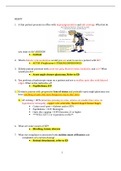HEENT
1.A thin patient presents in office with hyperpigmentation and salt cravings. What lab do you want to do? ADDISON
Cortisol
2.Which diabetic oral medication would you not want to use in a patient with HF?
ACTOS (Pioglitazone) (THIAZOLIDINEDIONES) 3.Elderly patient presents with acute eye pain, blurred vision, headache, and n/v? What would you do?
Acute angle closure glaucoma, Refer to ED
4.You perform a fundoscopic exam on a patient and see a swollen optic disc with blurred edges. What is this indicative of?
Papilledema, ICP
5.Geriatric patient with progressive loss of vision and probable open-angle glaucoma can
have notching of optic disc and changes in cup-to-disc ratio .
1.A V nicking = HTN ( arterioles pressing on veins, arteries are smaller than veins, its hypertensive retinopathy , copper wire arterioles, flamed shaped hemorrhages.
Cotton wool spots = diabetes and/or HTN
Papilledema = ICP/ Meningitis
Optic disc cupping = IOP/Glaucoma 22 or higher
***WILL GET 2 or 4 questions on this**
6.What are some causes of ICP?
Bleeding, tumor, abscess
7.What eye complaint is associated with sudden onset of floaters and complaints of a curtain closing?
Retinal detachment, refer to ED
1 8.What sinusitis is dental pain associated with? Maxillary
9.What is a white, gray patch on the tongue or in the mouth called? What is it associated with?
Leukoplakia, HIV and oral cancer 10.Adolescent presents with a painful, yellow ulcer with red base inside the mouth. What is
it?
Aphthous stomatitis, (canker sore) self-limiting. Resolves in 7-10 days. Can use magic mouthwash.
2.College student with single, painful, intra-oral lesion with yellow center and erythematous base has aphthous ulcer. Aphthous stomatitis (canker sores): Single ulcers could also be caused by trauma from biting, braces, tooth, hot food, toothbrush; food intolerance or allergy; stress; hormone changes; genes; medications; stopping smoking.
11.Besides avoiding allergens, what is the first line treatment for allergic rhinitis?
Intranasal steroids. (Budesonide)
12.A patient complains of swelling in the mouth, that is worse with meals, and comes and goes. It is commonly seen under the tongue and diagnose him with sialolithiasis. What is your treatment plan?
Increase fluids, moist heat, NSAIDS, abx if infected, and surgery to remove stone
2 13.On fundoscopic exam, you observe an artery crosses a vein and indents it. What is this associated with?
AV nicking, HTN
14.A pediatric patient has small, red papules with a white center on the inside of their mouth. What are they called? What are they associated with?
Koplik’s spots, Measles (Rubeola)
15.A patient has a cerumen impaction of the left ear . What would you see when performed a Rinne test? On Weber?
BC>AC (Rinne test)
lateralization to the left ear (Weber test) 16.In a patient with left ear infection, test should lateralize to the left ear.
17.Presbycusis is sensorineural hearing loss, especially at higher frequencies.
18.A carpenter comes in with complaints of a splinter (Astilla)in his eye. What would you do first?
Visual acuity
19.Patient was struck(golpeado) in the eye and c/o irritation and foreign body. Initial assessment is visual acuity. 20.A yellow, triangular thickening on the nasal side of the eye called?
Pterygium
3 21.What is the vascular area that anterior nosebleeds originate from?
Kiesselbach’s plexus
22.A 21-year-old female presents with complaints of nasal congestion for three weeks. She takes Afrin daily and NSAIDs, as needed, for migraines. What is the cause?
Afrin, or other nasal decongestant, use >3 days results in rebound congestion. This is called rhinitis medicamentosa 23.What is the most common organism in acute otitis media ? What is first line treatment?
S. Pneumoniae (Streptococcus pneumoniae ): TTO: Amoxicillin
What if the patient had an abx in the last three months ? Augmentin (Amoxicillin / Clavulanic Patient has hives(ronchas) with penicillin and Ceftin (cephalosporin) and complains of n/v with erythromycin. What do you give? Azithromycin (Macrolide) erythromycin, roxithromycin, azithromycin and clarithromycin. First-line indications for macrolides include the treatment of atypical community acquired pneumonia , H. Pylori (as part of triple therapy), chlamydia and acute non-specific urethritis.
24.Patient was treated for Acute otitis media two weeks ago, but still complains of inner ear fullness. You educate him on middle ear effusion and tell him that it can last up to?
8 weeks
25.Which patient is not at risk for H. Influenzae infection?
or a patient with Otitis externa?
26.What is the most common pathogen of Otitis externa?
Pseudomonas aeruginosa
Treat with? Corticosporin/hydrocortisone drops
4




